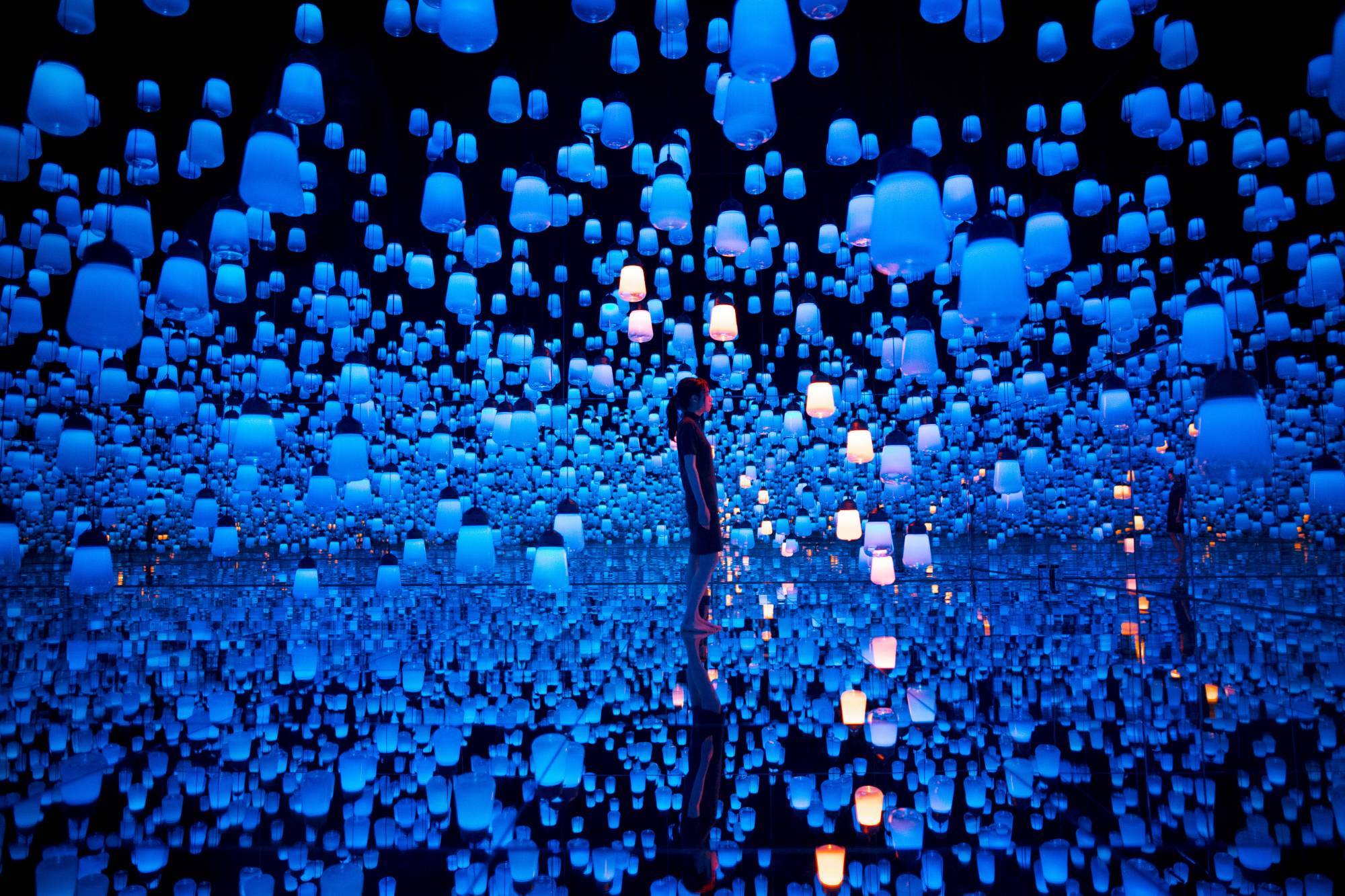teamLab, 2016, Interactive Installation, Murano Glass, LED, Endless, Sound: Hideaki Takahashi
In the essay, I am going to discuss on teamLAB’s interactive work: Forest of Resonating Lamps – One Stroke. I will give a summary of the artist and the chosen artwork. Also, I would further discuss the piece of artwork in relation to interactivity.
teamLAB founded in 2001 is an art collective, interdisciplinary group of ultra-technologists based in Japan. It brings together professionals from the various field of practices: artists, programmers, engineers, CG animators, mathematicians, architects, web and print graphic designers and editors. teamLAB aims to explore a new relationship between humans and nature, and between oneself and the world through art. As digital technology has allowed art to liberate itself from the physical and transcend boundaries. teamLAB sees no boundary between humans and nature, and between oneself and the world; one is in the other and the other in one. Everything exists in a long, fragile yet miraculous, borderless continuity of life.
In Norbert Weiner, “Cybernetics in History,” he mentions on the creation of cybernetics where communication and control come in hand in hand. Resulting in a reciprocal exchange and understanding of the message conveyed which follow a scientific pathway of a receptor, control and effector in a feedback loop. Additionally, in Nam Jun Paik, “Magnet TV”, establishes a process of direct feedback where there is no verbal exchange involved yet communication is established as the audience are welcome to interact with the magnet by mechanically adjusting the circuits to redirect the images into abstract, moving electronic patterns.

Similarity, teamLAB “Forest of Resonating Lamps – One Stroke”, a non-linear interactive artwork, the feedback loop is clearly shown as the interactiveness of the art piece will always depend on people – the idea of randomness and infinity are always present. When a person enters the space and stands still close to a lamp, it will shine brightly and emit a colour that resonated out. This first lamp becomes a starting point and starts to spread out to the two nearest lamps. The two lamps transmit the same colours to the other lamps, one after another, spreading continuously, resulting in a chain cycle. The light transmitted from the lamp always resonated out a bright light once, passing to the close lamps till all lamps have shone brightly once, and then returns to the first lamp. If the lights come from the other side of the room, it means that there is someone else standing there, and this way, people become aware of each other’s presence. The planar arrangement of the lamps is set in a zigzag manner that fills the space as part of a thought and orderly grid. This blend between the material and digital world immerses the visitor into an experience where changing lights illuminate a space that is bounded just by the floor and the mirrors used as walls.
Relating back to Nam Jun Paik, “Magnet TV”, this artwork does not need people to verbally communicate with the artwork or other people who are in the same place. Yet, they are able to interact with it by using the lights as a medium. There is a two-way communication to achieve stability and at the same time, there is indeterminacy involved in the artwork.
On the other hand, Roy Ascott, “Behaviourist Art and the Cybernetic Vision”, Ascott expands on Cage’s premise by suggesting that the spirits of cybernetics offer the most effective as he challenges artists to acknowledge information technology as the most significant tool of the age. His vision of cybernetics is that the interactive art must break away from the ideal “perfect object” in which the artwork should be responsive instead of being fixed and static. Similarly teamLAB believe that “digital technology can expand art and that digital art can create new relationships between people.” With the growth of technology, it allows more freedom and complex details. In the past, creative expression was expressed through a static medium through the use of physical objects such as canvas, paint or sculptures. As the advent of digital technology allowed human expression to become free from all these physical constraints, enabling to exist independently.
Forest of Resonating Lamps – One Stroke and Magnet TV are similar in term of the presence of people in relation to the artwork. As there is a need for the physical human form to be in the space to make the artwork be an artwork. So is an artwork not a piece of art when there is no presence of human? Or can an artwork be known as an artwork if it did not serve its main purpose?
Relating back to Ascott’s reading, Forest of Resonating Lamps – One Stroke is a behavioural art. Without people entering the space, the lamps wouldn’t light up. The lamp will be just placed as an installation without its main purpose. How the people view the artwork, or the environment where the artwork is installed can also affect on the artwork. By creating an interactive relationship between the viewers and the artworks, viewers become a part of the artwork.
In conclusion, with the growth of technology, art is created in a more creative way. And by integrating technology with it, it does not restrict the artist who just designs in a limited area. It also develops space adaptability by provides us with a greater degree of autonomy. Artists are now able to manipulate and use much larger amounts of space, allowing viewers to experience artworks more directly.
REFERENCE:
https://www.teamlab.art/about/
http://www.digitalmeetsculture.net/article/teamlab-tokyo-based-digital-artist-collaborative/
https://www.designboom.com/art/teamlab-forest-of-resonating-lamps-maison-et-objet-paris-09-05-2016/

You must be logged in to post a comment.